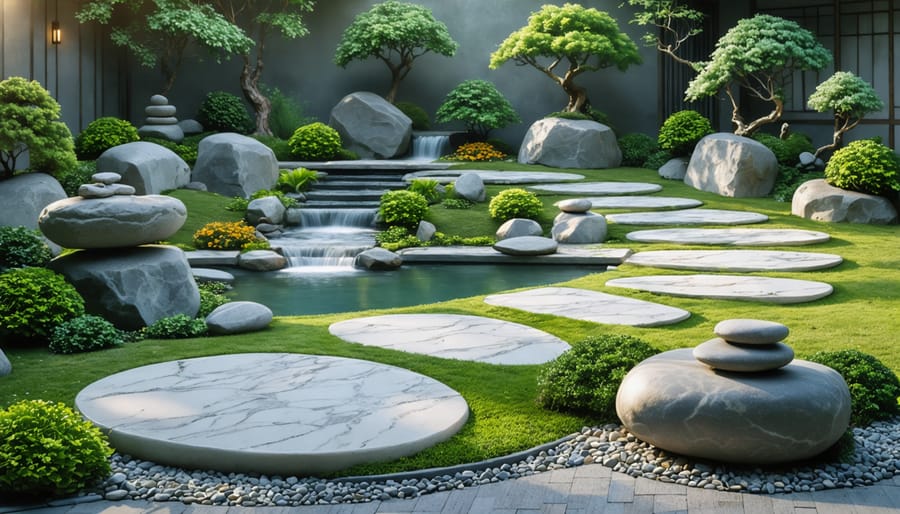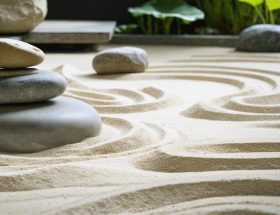Transform your space into a sanctuary of tranquility by harnessing the stress-relieving properties of natural stone alongside mindful design principles. Natural stone’s enduring presence grounds us in the present moment, creating an immediate connection to Earth’s ancient wisdom and stability. From the smooth, cool surface of marble meditation benches to the rugged authenticity of granite contemplation gardens, stone elements serve as powerful anchors for mindfulness practices.
The fusion of Zen philosophy with natural stone design transcends mere aesthetics – it creates spaces that actively promote mental clarity and emotional balance. Whether integrated into a private meditation room or a commercial wellness center, thoughtfully selected stone features can dramatically enhance the psychological impact of mindfulness practices.
Modern neuroscience confirms what ancient Zen masters understood intuitively: our physical environment profoundly affects our mental state. By incorporating natural stone elements that engage multiple senses – sight, touch, and even sound through water features – we create environments that naturally facilitate deeper states of mindfulness and presence.
The Ancient Connection Between Stone and Meditation
Traditional Zen Gardens and Stone Selection
In traditional Zen gardens, stone selection and placement were far from arbitrary choices. Masters understood the ancient connection between stone and meditation, carefully selecting rocks based on their shape, texture, and energetic qualities. Large, upright stones often represented mountains or spiritual guardians, while flat, horizontal stones symbolized water or earth elements.
The most revered stones possessed three essential qualities: height, depth, and balance. Garden designers sought naturally weathered stones with interesting patterns and asymmetrical forms, avoiding perfectly shaped or artificially altered rocks. They typically arranged stones in groups of three, five, or seven, creating triangular compositions that drew the eye inward and promoted contemplative states.
Color played a crucial role, with dark, muted tones preferred for their ability to absorb rather than reflect light. Moss-covered stones were particularly valued, as they represented the passage of time and connection to nature. The spaces between stones, known as ma, were considered equally important as the stones themselves, creating a rhythm that guided meditation practice and encouraged mindful observation.
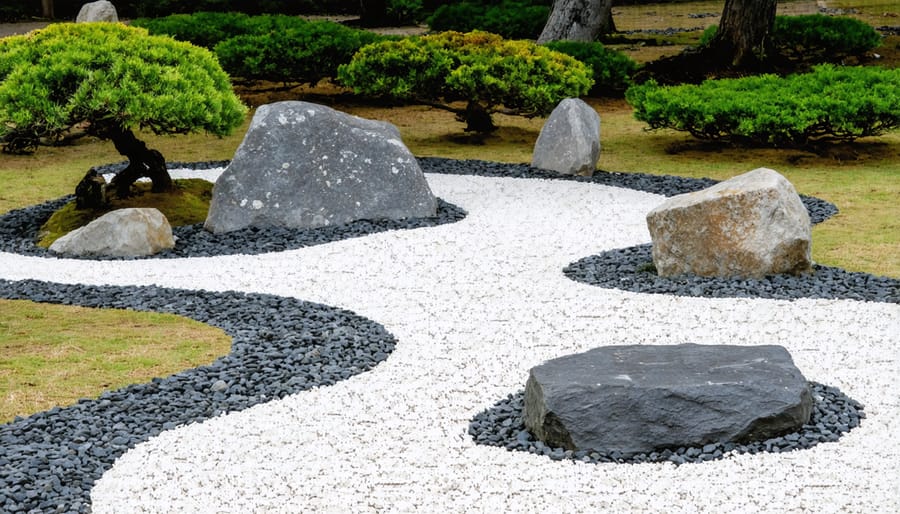
Modern Interpretations of Stone Meditation Spaces
Contemporary designers are reimagining traditional Zen meditation spaces by blending ancient principles with modern aesthetics. Natural stone remains at the heart of these designs, with architects favoring minimalist arrangements that emphasize clean lines and uncluttered spaces. Popular choices include honed granite for meditation benches, slate for pathways, and basalt columns for water features.
Modern interpretations often incorporate sustainable elements, such as permeable stone pavers that allow rainwater to nourish surrounding gardens. Glass walls frequently complement stone elements, creating a seamless connection between indoor meditation spaces and outdoor rock gardens. This integration helps practitioners maintain their connection with nature while enjoying climate-controlled environments.
Leading wellness centers and corporate campuses are increasingly adopting these design principles, installing meditation courtyards with carefully positioned stone elements. These spaces typically feature smooth river rocks for contemplative arrangements, locally sourced boulders as focal points, and crushed stone pathways that encourage mindful walking meditation.
The key to successful modern stone meditation spaces lies in their ability to honor traditional Zen principles while meeting contemporary needs for functionality and accessibility.
Creating Mindful Spaces with Natural Stone
Water Features and Reflection Pools
Water features incorporating marble and granite create serene focal points that enhance meditation spaces through their natural beauty and soothing sounds. The reflective properties of polished stone surfaces, combined with flowing water, create an atmosphere conducive to mindfulness and contemplation.
Marble’s translucent qualities allow light to interact with water in unique ways, creating subtle illumination effects that change throughout the day. White marble varieties like Carrara and Calacatta are particularly effective in reflection pools, as their light coloring amplifies the water’s reflective qualities while maintaining visual clarity.
Granite’s durability makes it ideal for outdoor water features exposed to the elements. Its varied textures can be manipulated to create different water flow patterns, from gentle ripples to dramatic cascades. Dark granite varieties like Absolute Black provide striking contrast when used in reflection pools, creating mirror-like surfaces that enhance meditation experiences.
When designing water features for mindfulness spaces, consider incorporating:
– Smooth, honed stone surfaces for peaceful water movement
– Rough-cut stone edges for natural waterfall effects
– Strategically placed stone benches near water features
– LED lighting beneath water for evening meditation
– Multiple levels or terraces to create gentle water sounds
Regular maintenance of stone water features ensures their meditative qualities remain intact. Proper sealing prevents water absorption and protects against mineral deposits, while periodic cleaning maintains the stone’s natural beauty and reflective properties.
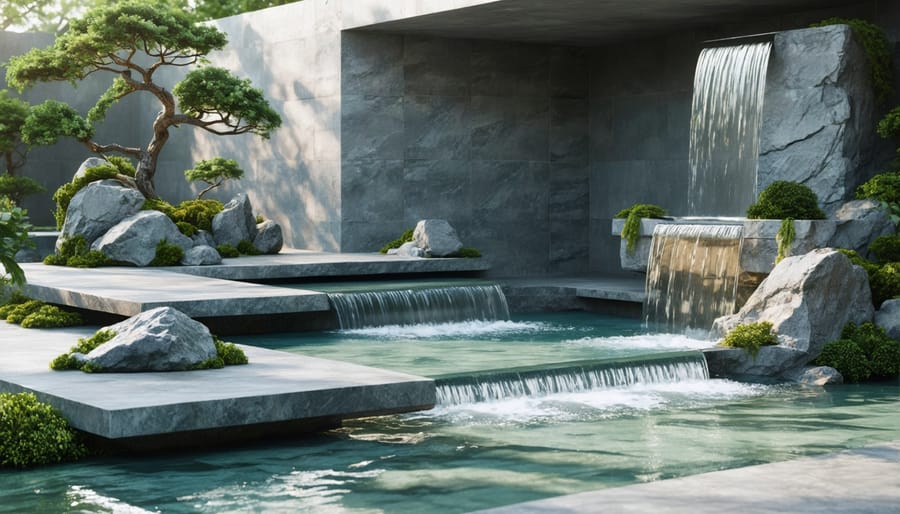
Meditative Walking Paths
Creating a meditative walking path with natural stone requires careful consideration of both design principles and mindful elements. The key lies in selecting stones that promote a sense of grounding while arranging them in patterns that encourage slow, deliberate movement.
Begin by choosing flat, stable stones with gentle textures that invite bare feet to connect with the earth. Slate, sandstone, and granite are excellent options, offering both durability and natural variation in color. Space the stones at comfortable stepping distances, typically 18-24 inches apart, allowing walkers to maintain a natural gait while staying present in their movement.
Consider incorporating curves rather than straight lines in your path design. Gentle meandering encourages slower walking and heightened awareness of surroundings. The Japanese concept of “hidden reveal” can be applied by partially obscuring sections of the path with strategic plantings or stone arrangements, creating moments of discovery that enhance mindful engagement.
Transitions between stones should be smooth and intentional. Use smaller pebbles or gravel between larger stepping stones to create visual flow and provide stable footing. Include wider “pause points” at regular intervals, using larger stones or small platforms where practitioners can stop and center themselves.
The surrounding landscape should complement the path’s meditative purpose. Incorporate elements like moss, low-growing groundcover, or ornamental grasses that soften edges and add sensory dimension to the walking experience. Sound elements, such as stone water features, can enhance the contemplative atmosphere while masking external noise.
Indoor Zen Corners
Natural stone elements can transform an indoor space into a serene meditation sanctuary, creating a powerful connection between mindfulness practice and the earth’s ancient materials. The key to designing an effective zen corner lies in thoughtful stone selection and mindful placement.
Consider incorporating a small water feature with smooth river rocks, which provides both visual appeal and gentle, meditative sounds. Alternatively, a carefully arranged collection of polished stones on a wooden platform can serve as a focal point for contemplation. Granite or slate flooring tiles can ground the space, while strategically placed marble or limestone accents add subtle elegance without overwhelming the senses.
For vertical elements, consider installing a natural stone accent wall using stacked slate or textured limestone. These surfaces not only provide visual interest but also help absorb sound, creating a quieter environment conducive to meditation. Small stone benches or meditation cushions placed on stone platforms can define the seating area while maintaining the natural aesthetic.
Lighting plays a crucial role in enhancing stone features. Soft, indirect lighting can create subtle shadows and highlight the natural textures of stone surfaces. Consider placing Himalayan salt lamps or stone lanterns to add warm, ambient lighting that complements the peaceful atmosphere.
When selecting stones, opt for earth tones and natural finishes that promote tranquility. Avoid highly polished or busy patterns that might distract from the meditative experience. Remember, simplicity is key in creating a space that encourages mindfulness and inner peace.
Selecting Stones for Mindful Spaces
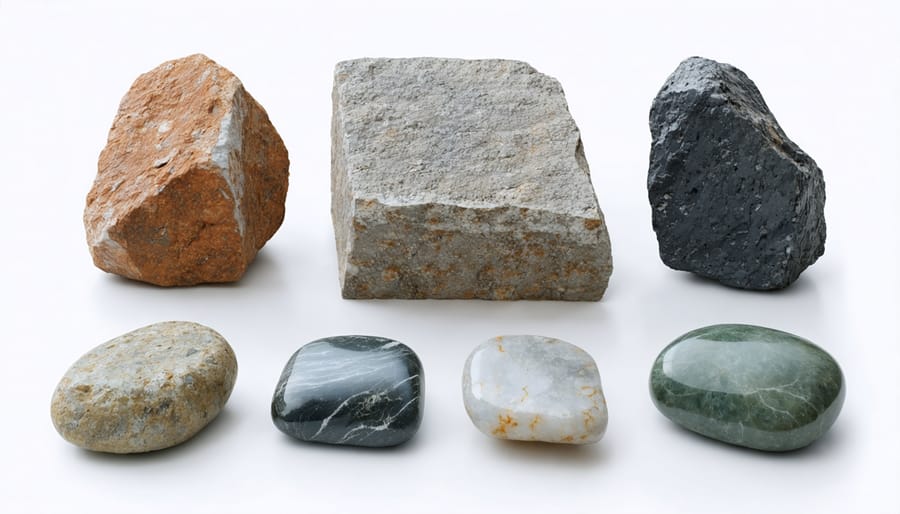
Texture and Visual Impact
The surface finish of natural stone plays a pivotal role in creating mindful spaces, with each texture evoking distinct emotional responses. The calming effects of stone textures can significantly influence the meditation experience and overall atmosphere of a space.
Polished surfaces create a reflective, mirror-like finish that brings clarity and brightness to a room, often associated with mental clarity and focused meditation. This smooth texture invites touch and can serve as a visual anchor during contemplative practices. In contrast, honed finishes offer a soft, matte appearance that reduces glare and creates a more subdued environment, perfect for gentle reflection and peaceful meditation.
Leathered or brushed finishes provide a subtle texture that maintains the stone’s natural character while offering a tactile experience that grounds practitioners in the present moment. These surfaces create a connection to nature’s raw beauty, enhancing the mindfulness experience. Rough-hewn or split-face textures, commonly used in outdoor meditation gardens, create dramatic shadow play and emphasize the stone’s organic qualities, fostering a deeper connection with the natural world.
For optimal results in mindfulness spaces, consider combining different stone finishes strategically. For example, use smoother textures for meditation seating areas and more textured surfaces for peripheral elements that define the space’s boundaries and create visual interest without distraction.
Color Psychology in Stone Selection
The colors of natural stone play a vital role in creating meditative spaces, with each hue carrying distinct psychological effects that can enhance or detract from your mindfulness practice. Light-colored stones like white marble and cream limestone promote clarity and openness, making them excellent choices for meditation rooms where mental decluttering is essential.
Gray stones, such as slate and certain granites, provide a neutral foundation that helps ground energy and reduce mental stimulation. These understated tones create a sense of stability and calm, allowing practitioners to focus inward without environmental distractions.
Earthy browns and tans, found in travertine and sandstone, connect us to nature and promote feelings of security and warmth. These colors are particularly effective in creating a safe, nurturing environment for deeper meditation practices.
For spaces designed to energize and inspire, stones with subtle warm undertones can provide gentle stimulation without overwhelming the senses. However, highly varied or dramatically veined stones should be used sparingly in meditation spaces, as they can create visual noise that interferes with mental clarity.
When selecting stone colors for mindfulness spaces, consider the room’s natural light and size. Darker stones can create an intimate atmosphere in larger spaces, while lighter stones can help smaller meditation areas feel more expansive and breathable. The key is finding a balance between visual interest and tranquil simplicity that supports your mindfulness journey.
Maintenance for Peaceful Environments
Maintaining stone elements in your zen space is crucial for preserving their tranquil qualities and ensuring they continue to enhance your mindfulness practice. Regular maintenance not only protects your investment but also deepens your connection with these natural elements through mindful care.
Begin with gentle daily cleaning using a soft cloth or brush to remove dust and debris. This simple act can become part of your mindfulness routine, allowing you to observe and appreciate the unique patterns and textures of your stone features. For deeper cleaning, use pH-neutral cleaners specifically formulated for natural stone, avoiding harsh chemicals that can damage the surface and disturb the peaceful atmosphere.
Water features require special attention to maintain their calming effects. Check water levels regularly, clean filters monthly, and ensure proper circulation to prevent stagnation. The sound of flowing water is essential for creating a meditative atmosphere, so address any unusual noises promptly.
For stone pathways and meditation areas, inspect regularly for loose stones or uneven surfaces that might disturb your practice. Seal outdoor stone elements annually to protect against weather damage and maintain their natural beauty. Indoor stone features typically need sealing every 3-5 years, depending on use and exposure.
Consider the changing seasons and how they affect your stone elements. In winter, avoid using de-icing salts near stone features, as they can cause damage and disrupt the natural aesthetic. Instead, use sand or cat litter for traction. During warmer months, prevent plant growth between stones by maintaining proper drainage and removing any vegetation that could compromise the structure.
Incorporate mindful observation into your maintenance routine. Notice how light plays across the stone surfaces at different times of day, how rain affects their appearance, and how they weather naturally over time. This awareness helps you maintain not just the physical aspects of your stone elements, but also their spiritual and meditative qualities.
The integration of natural stone in mindfulness practices and meditation spaces offers profound benefits that extend far beyond mere aesthetics. The transformative power of natural stone creates environments that naturally facilitate deeper meditation, stress reduction, and spiritual connection. By incorporating elements like granite, marble, or slate into meditation spaces, practitioners can benefit from the grounding energy and timeless presence these materials provide.
Natural stone’s ability to regulate temperature and humidity while providing excellent acoustic properties makes it an ideal choice for creating balanced, harmonious environments conducive to mindfulness practices. The subtle variations in texture, color, and pattern found in natural stone surfaces serve as powerful focal points for meditation, helping practitioners maintain present-moment awareness and concentration.
The durability and permanence of stone also serve as powerful metaphors for the steadfast nature of mindfulness practice itself. As we seek to cultivate stability in our mental states, the unchanging presence of natural stone provides a tangible reminder of the qualities we aim to develop within ourselves.
Whether used in home meditation corners, yoga studios, or large-scale wellness centers, natural stone creates spaces that inherently support contemplative practices while offering practical benefits that enhance the overall meditation experience. This harmonious blend of function and spirituality makes natural stone an invaluable element in creating environments dedicated to mindfulness and inner peace.

